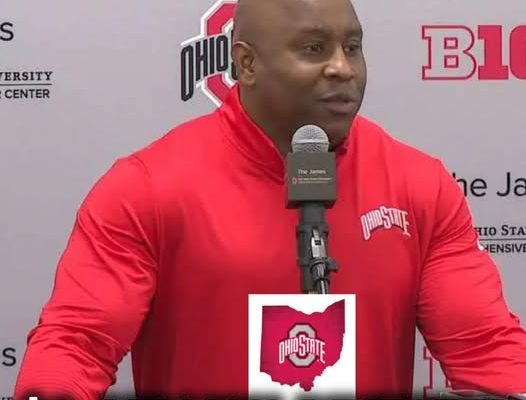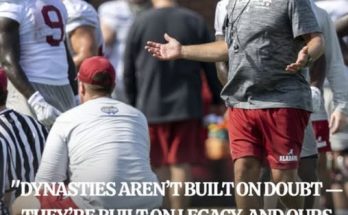In the ever-intensifying arms race that is college football recruiting and coaching acquisitions, a story emerged this week that sent ripples across the Big Ten landscape and reinforced a clear message in Columbus—Ohio State is not just a destination; it’s a commitment. Carlos Locklyn, the Buckeyes’ rising star running backs coach, has reportedly turned down a staggering $2 million offer from conference rival Penn State. This development not only speaks volumes about Locklyn’s loyalty and long-term vision but also highlights the strategic maneuvers unfolding behind the scenes as programs across the nation seek to assemble elite coaching staffs to compete for championships in a new era of college football.
Carlos Locklyn’s decision to remain in Columbus despite being pursued with what many are calling an unprecedented offer for an assistant coach speaks to the evolving value placed on positional coaching in today’s game. The $2 million figure floated by Penn State isn’t just large—it would have placed Locklyn among the highest-paid assistant coaches in the nation, possibly even rivaling the salaries of some Power Five coordinators. And yet, the offer was declined. For Ohio State fans, this is more than a win—it’s a message of reassurance that one of the game’s brightest coaching minds is staying put to continue building what many believe is the most talented backfield room in the country.
What makes Locklyn’s decision even more compelling is the context of his rapid rise in the coaching profession. A former standout at Chattanooga and a former high school and college player-turned-coach, Locklyn didn’t take the traditional route to prominence. His work ethic, authenticity, and reputation as a recruiter have allowed him to climb quickly through the ranks. Stops at Memphis, Western Kentucky, and Oregon showcased his ability to connect with players, install tough-nosed run schemes, and most importantly, win on the recruiting trail. When Ryan Day brought him to Ohio State, it was clear he had secured a game-changer. Since arriving in Columbus, Locklyn has played a vital role in shaping the future of Ohio State’s running back position, helping to land and develop elite talent in a competitive recruiting era that has only become more cutthroat with NIL and transfer portal dynamics.
The news of Penn State’s failed coup attempt should not be brushed off as mere rumor or offseason noise. Penn State head coach James Franklin has never been shy about aggressively pursuing top-tier coaching talent, particularly within the conference. His pursuit of Locklyn is a bold indication that Penn State sees Ohio State not just as a rival, but as the standard it must dethrone. By targeting a coach so integral to the Buckeyes’ offensive identity, Franklin was likely attempting to both strengthen his own staff and weaken a direct competitor in one stroke. Offering $2 million—a figure that dwarfs the average salaries of most position coaches—is indicative of just how highly Locklyn is valued. That such a bid was ultimately rebuffed says as much about Ohio State’s internal culture and stability as it does about Locklyn’s personal principles.
While specific contractual details at Ohio State remain undisclosed, it’s widely understood that Ryan Day and athletic director Gene Smith have made keeping elite talent—both players and coaches—a program priority. With Locklyn’s decision, they’ve succeeded in fending off a financial ambush from a peer institution with deep pockets and high ambitions. The Buckeyes are in the middle of one of the most important offseasons in recent memory, as they gear up for a season that will feature an expanded College Football Playoff, a loaded schedule, and a roster brimming with NFL-caliber talent. Continuity on the coaching staff, especially in position rooms as vital as running back, could be the difference between merely competing and actually winning a national title.
Recruiting is where Locklyn’s impact is most deeply felt. In the past two cycles alone, he’s been instrumental in landing five-star backs and flipping the perception of Ohio State’s ability to dominate in the trenches and on the ground. His relationships with players and their families are often cited as the deciding factor in their commitments. Beyond his recruiting prowess, Locklyn is known for developing an old-school toughness in his backs—a quality that aligns perfectly with Ohio State’s brand of smashmouth-meets-speed football. In an age where offensive innovation often leans toward the pass-heavy, Locklyn is one of the few coaches who still knows how to build a ground game that can dominate for four quarters.
That Penn State wanted him—and was willing to back that desire with such a high-dollar offer—shouldn’t surprise anyone who follows the sport closely. The Nittany Lions have been knocking on the door of Big Ten supremacy for years, and their inability to consistently outplay Ohio State and Michigan has left them searching for any competitive edge. Franklin’s attempt to poach Locklyn was not just a bold chess move—it was a signal that Penn State knows exactly which figures are driving Ohio State’s sustained excellence.
For Locklyn, this moment may represent a defining turning point in his career. Turning down such an eye-popping deal not only solidifies his image as a coach who isn’t just chasing a paycheck, but also as someone who values stability, development, and legacy. With whispers already beginning to circulate about head coaching opportunities in the not-so-distant future, remaining at Ohio State gives him a platform that few programs can match. His continued success in Columbus will likely lead to offers much bigger than $2 million in the coming years—but this time for head coaching roles at marquee programs.
It’s also worth considering how Locklyn’s decision impacts the locker room and the wider college football coaching community. Players—especially top recruits—pay close attention to coaching changes. In an era defined by constant movement, Locklyn’s choice sends a signal of trust and steadiness. Running backs currently committed to Ohio State, and those considering a future with the program, now know their coach isn’t going anywhere. That kind of stability is invaluable in the modern recruiting game, where continuity often carries more weight than scheme.
Furthermore, this moment may cause other programs to reevaluate their own strategies. Offering $2 million to a position coach is a sign that market inflation is real, and that elite programs are no longer reserving top dollar exclusively for coordinators and head coaches. The financial arms race in college football continues to escalate, and Locklyn’s value—regardless of the outcome—has now been established at a national level. Ohio State, by keeping him, has effectively signaled that they’re willing to go toe-to-toe with anyone to retain their top personnel.
The timing of this development is also notable. With the 2025 season approaching and Ohio State widely regarded as one of the top contenders for the national title, Locklyn’s presence on staff adds another layer of confidence for fans and boosters alike. The Buckeyes boast a loaded running back room, including returning stars and incoming freshmen that Locklyn personally scouted, recruited, and molded. His departure could have thrown a wrench into that continuity. Instead, his decision to stay ensures that the system, relationships, and trust remain intact.
It’s tempting to view this episode solely through the lens of a financial tug-of-war, but it also underscores deeper philosophical divisions between programs. Ohio State’s culture—emphasizing development, internal loyalty, and alignment—may have been the ultimate difference-maker. Locklyn’s decision suggests that the Buckeyes have built something stronger than just a brand—they’ve created an environment where coaches want to stay, even when tempted with life-changing money.


